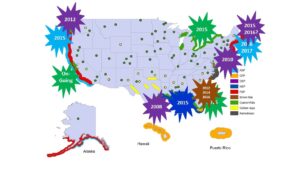The National Centers for Coastal Ocean Science (NCCOS) awarded $1.68M (million) in Fiscal Year 2017 funding for nine research projects to identify conditions increasing bloom toxicity, model toxin movement from water into shellfish, fish, and marine mammals, and improve toxin monitoring and forecasts. These multi-year awards from the NCCOS competitive programs, ECOHAB and PCMHAB, with a total funding target of $5.2M through 2019, will have a national impact.
- The University of Alaska Fairbanks and the Sitka Tribe of Alaska received $247K (thousand) to uncover the mechanisms behind wintertime occurrences of Paralytic Shellfish Poisoning toxicity in geoduck clam fisheries in Southeast Alaska
- The University of California Santa Cruz received $130K to Investigate interactions between the toxin-producing algal diatom Pseudo-nitzschia and marine bacteria in controlling domoic acid biosynthesis and toxic bloom formation
- The Florida Fish and Wildlife Institute of the Florida Fish and Wildlife Commission received $90K to partner with the U.S. Food and Drug Administration integrating alternate methods of analysis to the classical mouse bioassay into the Neurotoxic Shellfish Poisoning monitoring and management framework
- The Florida Gulf Coast University and its partners at the University of South Alabama and Dauphin Island Sea Lab, Woods Hole Oceanographic Institution, and University of the Virgin Islands received $250K to study hyper-toxic strains (“super-bugs”) of the ciguatera disease-causing dinoflagellate Gambierdiscus and ciguatoxin fate in coral reef food webs
- The Bigelow Laboratory for Ocean Sciences and the Maine Department of Marine Resources received $50K to expand options for monitoring diarrhetic shellfish poisoning (DSP) by accelerating regulatory approval of two accurate and rapid screening methods for DSP toxins
- The University of Maryland received $166K to couple a hydrodynamic-biogeochemical model to a new harmful algal bloom model to predict toxic blooms of Prorocentrum minimum and Karlodinium veneficum in Chesapeake Bay
- The Ohio State University and its partners at LimnoTech (Inc.), Michigan Technological University, University of Toledo, Bowling Green State University, and Wayne State University received $248K to link models and field experiments to forecast the potential toxicity of Microcystis cyanobacterial blooms in Lake Erie
- The Virginia Institute of Marine Science (College of William and Mary) received $250K to partner with four other institutions for cross-regional comparisons (Gulf of Mexico, Puget Sound, Long Island Sound and Chesapeake Bay) of the ecology and toxicity of the DSP-causing dinoflagellate Dinophysis
- The Virginia Institute of Marine Science received $249K to study the toxicity and food web impacts of Alexandrium monilatum and its toxins in Chesapeake Bay.

“These projects support the Harmful Algal Blooms and Hypoxia Comprehensive Research and Action Plan mandated by the 2014 HABHRCA Reauthorization,” said Dr. Alan Lewitus, Director of the NCCOS Competitive Research Program. “The Florida and Maine projects specifically support Interstate Shellfish Sanitation Conference (ISSC) efforts that foster and promote shellfish sanitation through the cooperation of state and federal control agencies, the commercial shellfish industry, and the academic community.”
Added Dr. Quay Dortch, ECOHAB and PCMHAB Program Manager, “These projects have clear links to management, for example the ISSC, and their outputs and outcomes will provide managers and the public with sound scientific information for making decisions.”
A list of the awards is available online. See the NOAA Press Release for more information.
